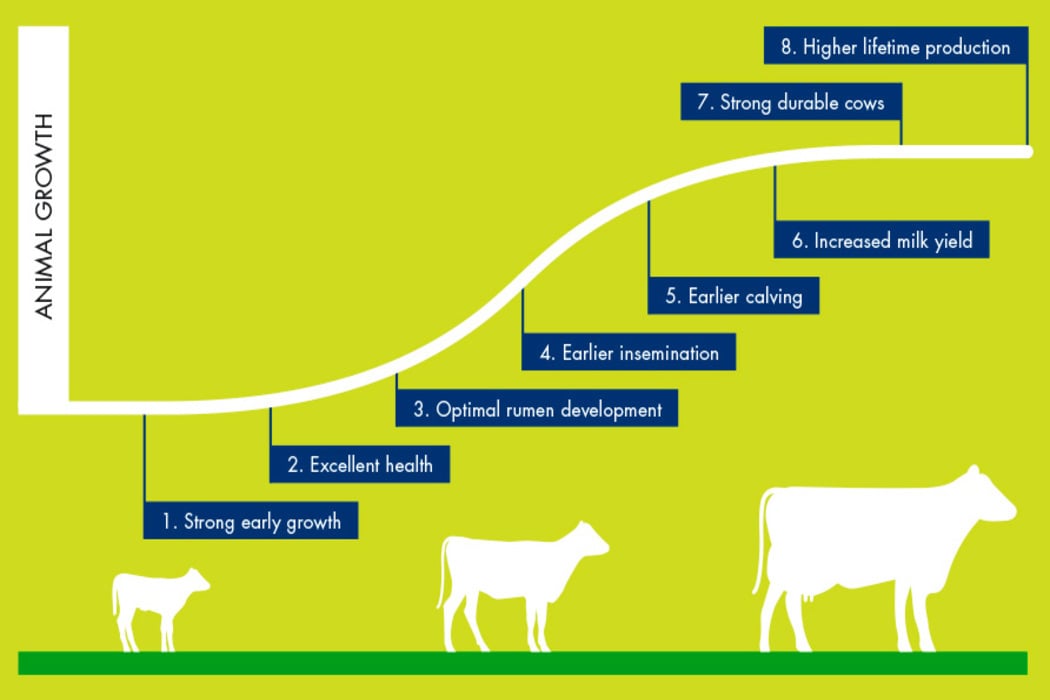
LifeStart Results
LifeStart feeding schedules allow for earlier breeding
Research has shown that the quality of nutrition has a strong influence on pre-weaning growth[1,2,3,4,5,6,7,8,9]. As a result, the age at which heifers can be inseminated for the 1st time will go down[6,10]
In a study carried out by Bolt et al[11], a group of 2,259 calves fed according to a restricted feeding schedule was compared to a group of 1,435 calves fed an intensive feeding schedule. Both groups were weaned at 63 days of life. The calves on an intensive feeding schedule consumed an average of 403 litres of CMR compared to 308 litres for the restricted feeding group.
Significant differences in growth up to day 63 were found between the groups with the calves fed the intensive feeding schedule weighing 92.2 kg and the calves fed a restricted feeding schedule weighing 78.8 kg (p<0.0001).

The age at first insemination was lower in the calves fed the intensive feeding schedule (15.0 vs. 15.3 months, they required fewer inseminations (1.7 vs. 2.1) and calved earlier (24.8 months vs. 25.5 months) but none of these differences were significant.
The Trouw Nutrition Kempenshof trial
Material and methods
A total 86 individually housed female calves were included in a longitudinal study carried out in the Kempenshof12. Pairs were fed the same amounts of colostrum from the same source and blocked by colostrum, parity and season. The only difference between the two groups was the amount of calf milk replacer fed. The LifeStart group was fed 8 litres per day compared to 4 litres per day for the controls, both groups were fed at a concentration of 150 g/l.
|
|
Conventional |
LifeStart |
Difference |
p-value |
| First insemination | 399 | 393 | 6 | 0.39 |
| Age at conception | 424 | 408 | 16 | 0.04 |
| Age at first calving | 699 | 684 | 15 | 0.10 |
Results
As a result of the LifeStart feeding schedule, fertility improved leading to a reduction of the age at 1st calving.
References
[1] Shamay, A., D. Werner, U. Moallem, H. Barash, and I. Bruckental. 2005. Effect of nursing management and skeletal size at weaning on puberty, skeletal growth rate, and milk production during first lactation of dairy heifers. J. Dairy Sci. 88:1460–1469.
[2] Faber, S. N., N. E. Faber, T. C. McCauley, and R. L. Ax. 2005. Case study: Effects of colostrum ingestion on lactational performance. Prof. Anim. Sci. 21:420–425.
[3] Morrison, S. J., H. C. F. Wicks, R. J. Fallon, J. Twigge, L. E. R. Dawson, A. R. G. Wylie, and A. F. Carson. 2009. Effects of feeding level and protein content of milk replacer on the performance of dairy herd replacements. Animal 3:1570–1579.
[4] Davis Rincker LE, VandeHaar MJ, Wolf CA, Liesman JS, Chapin LT and Weber Nielsen MS, Effect of intensified feeding of heifer calves on growth, pubertal age, calving age, milk yield, and economics. J. Dairy Sci 94:3554-3567 (2011).
[5] Moallem, U., D. Werner, H. Lehrer, M. Zachut, L. Livshitz, S. Yakoby, and A. Shamay. 2010. Long-term effects of ad libitum whole milk prior to weaning and prepubertal protein supplementation on skeletal growth rate and first-lactation milk production. J. Dairy Sci. 93:2639–2650.
[6] Raeth-Knight, M., H. Chester-Jones, S. Hayes, J. Linn, R. Larson, D. Ziegler, B. Ziegler, and N. Broadwater. 2009. Impact of conventional or intensive milk replacer programs on Holstein heifer performance through six months of age and during first lactation. J. Dairy Sci. 92:799–809.
[7] Drackley, J. K., B. C. Pollard, H. M. Dann, and J. A. Stamey. 2007. First-lactation milk production for cows fed control or intensified milk replacer programs as calves. J. Dairy Sci. 90(Suppl. 1):614 (Abstr.).
[8] Terré, M., C. Tejero, and A. Bach. 2009. Long-term effects on heifer performance of an enhanced growth feeding programme applied during the pre-weaning period. J. Dairy Res. 76:331–339.
[9] Soberon F, Raffrenato E, Everett RW and Van Amburgh ME. 2012. Preweaning milk replacer intake and effects on long-term productivity of dairy calves. J. Dairy Sci. 95:783-793.
[10] Bar-Peled et al., 1997. Increased weight gain and effects on production parameters of Holstein heifer calves that were allowed to suckle from birth to six weeks of age. J. Dairy Sci; 80:2523-8.
[11] Bolt, A. 2019, Meta-analysis to calculate the effect of rearing intensity on functionality of dairy cows, Research paper Mecklenburg Vorpommern Landesforschungsanstalt für Landwirtschaft und Fischerei. [12] Data on file, Study report R06201B.







